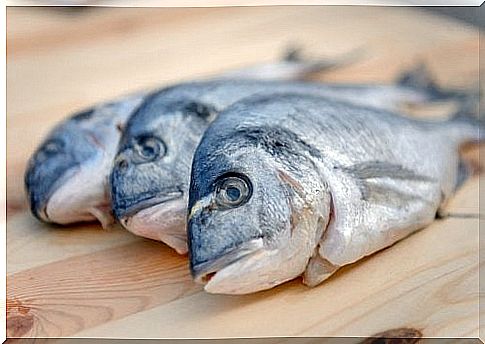Is The Mercury In Fish Dangerous?
Fish mercury is found basically in large blue fish. Pregnant women and children should be especially careful with its ingestion. Find out more about it here.

We know that eating fish is beneficial for health because of its intake of unsaturated fatty acids. However, there is some concern about the hazards that mercury can produce in fish.
So, in this article, we will see if mercury is really dangerous, how much we can safely consume, as well as in which fish it is found in greatest quantity. We give you more information here!
Mercury in fish
Mercury is found naturally in soil, water, plants and animal bodies. The problem is that human activity brings large amounts of mercury to the environment, through the incineration of solid residues, the use of fossil fuels or the use of industries of this metal.
Mercury passes into fish through food, so that the most predatory fish, which are also the largest, accumulate more of it.
The risks of consuming mercury in fish
The toxicity of mercury depends on its chemical form, type, dose of exposure and the age at which it is produced. Of all the chemical species of mercury found in foods, the organic compound methylmercury is the one that shows the greatest toxicity. It is the same that is found mostly in fish and seafood.
This chemical form can affect the kidneys and the central nervous system, especially during development, through a blood-brain barrier such as the placenta. Methylmercury can also cause alterations in normal brain development in breastfed babies and, in larger doses, induce neurological changes in adults.
In which fish is mercury primarily found?

The highest concentrations of mercury are found in freshwater and saltwater fish. Especially in large species, located at the highest level of the food web.
Bigeye tuna
Tuna is one of the fish that contains the most alarming amounts of mercury. However, it is not the Mediterranean tuna that should worry us, but rather the bigeye tuna. This variety of tuna lives in tropical and subtropical areas of the Atlantic, Indian and Pacific Oceans.
We can therefore remain calm, since Mediterranean bluefin tuna does not contain such high percentages of mercury. And the same goes for light tuna.
Swordfish
Swordfish is one of the commercially sold fish that contains the highest amounts of mercury. It is a predator that consumes a lot of fish every day. Thus, it only increases the amounts of mercury in his body.
Shark
This species also has high percentages of mercury. Sharks range from small to larger species, such as the whale shark.
Pike
The pike is a large predator that feeds on species of all types, even crabs.
How much fish can we eat without endangering our health?

The European Food Safety Authority (EASA) recommends limiting the intake of bluefin tuna, swordfish, sharks and pike. However, it is necessary to take into account the origin of the meat, since some waters are more contaminated than others.
The Joint FAO / WHO Expert Committee on Food Additives revised in June 2003 the weekly amount of methylmercury that is tolerable to ingest. It thus went from 3.3 μg / kg of body weight to 1.6 μg / kg of body weight.
The EASA recommendations are as follows:
- Pregnant women, those who may be pregnant or those who are breastfeeding should avoid consuming it.
- Children under 3 years old should avoid consuming it
- Children between 3 and 12 years old should limit their consumption to 50g per week or 100g for 2 weeks (do not consume any other fish in this category during the same week)
Recommendations on fish consumption
Fish is essential for a balanced diet. Indeed, it provides proteins of high biological value, vitamins A, D and B12, iodine and selenium. A diet that contains fish and seafood will help maintain our cardiovascular health. In contrast, no relationship has been proven between mercury ingestion and the risk of coronary heart disease.
If we take into account the benefits of DHA fatty acids, we can say that compared to the risk of mercury, the consumption of fish in women of childbearing age, pregnant and breastfeeding reduces the risk of abnormal neurological development in children.
It is essential to alternate the fish we eat:
- Preferably choose other types of blue fish such as sea bass, sea bream, salmon, sardines, trout, etc.
- Do not eat fish containing a high amount of mercury, such as tuna, swordfish, pike or shark more than once a week
- Avoid consuming canned tuna frequently. Researchers conducted a study in which they looked at university students who frequently ate cans of tuna. They were able to find greater levels of mercury in the hair of these students than in the hair of those who did not consume it.
- Alternate blue fish with white fish, which contain less mercury
In summary
The high concentrations of mercury in various varieties of fish are sufficient reasons to limit their intake. Consumption of mercury is linked to a greater risk of health problems. However, it should not be ignored that, on the contrary, other varieties of fish are beneficial for the organism.









